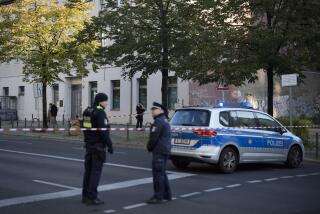City to Rebuild Symbol of its Destruction : Dresden: Bombed out by the Allies in World War II, a historic church reminds residents of what they lost.
- Share via
DRESDEN, Germany — For 47 years, the ruins of the Frauenkirche have reminded the world of two days in 1945 when Allied bombers bathed this graceful city in fire, killing tens of thousands of people.
Now Dresden plans to rebuild the Frauenkirche, once the most important Lutheran church in Germany.
Only two walls remain standing. The rest of the church lies in a huge mound of rubble. Ornate 18th-Century carving is visible on the sandstone blocks.
“The Frauenkirche will always be a memorial to World War II and to war in general, “ said Barbara Hintzen, spokesman for the city.
The ambitious rebuilding project symbolizes Dresden’s determination to recover fully and finally from World War II and the Communist rule that it.
Older Dresdeners remember the bombings of Feb. 13-14, 1945. They tell of buildings swaying in the firestorm, the injured begging for food and water, of the smoldering aftermath that kept everyone out of the city’s heart for days.
“They hurled firebombs down and people looked like living, burning torches,” said Elfriede Stephan, 57, who was staying just outside the city when the bombers came.
Bodies were burned past recognition. The heat melted bottles. A storm-like wind roared through the city.
Estimates of the dead range from 35,000 to more than 100,000. At the time, the city was jammed with an estimated 500,000 refugees fleeing the Soviet army advancing from the east.
Photographs of the horror hang on the walls of many historic buildings in Dresden.
Many Dresdeners are appalled by plans to erect a statue in London of Sir Arthur (Bomber) Harris, the Royal Air Force commander who planned the mass bombing attacks on the civilians of Dresden and other German cities.
“This statue will strike wounds in the hearts of the people of Dresden,” Hintzen said. “Nearly every family, one way or another, had someone who was killed there.”
Hitler was near defeat when the raids took place, and many in Dresden insist they served no military purpose.
The Frauenkirche collapsed the morning after the firebombing began.
Communist officials left the church in ruins as a reminder of the “struggle against imperialistic barbarianism.”
Hans-Joachim Jaeger, who heads the rebuilding drive, hopes contributions will come from around the world to finance the 10-year reconstruction.
Preliminary work is under way. As many of the original stones as possible will be used in rebuilding the church, which combined classical and baroque architectural styles.
Estimates of the rebuilding cost range from $100 million to more than three times that. Some higher estimates are from opponents of the rebuilding drive who say the money should be used for other purposes.
Dresden, population 520,000, is a favorite of Germans. They call it “Florence on the Elbe” and “the pearl of eastern Germany.”
Buildings in the historic center are ringed with scaffolds where workmen labor to restore the city’s past glories. Trendy restaurants have moved into the area and a castle nearly demolished in the firebombing also is being rebuilt.
More to Read
Sign up for Essential California
The most important California stories and recommendations in your inbox every morning.
You may occasionally receive promotional content from the Los Angeles Times.













